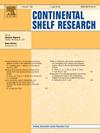The dynamics of the inner-shelf suspended sediments based on ADCP records and Rouse theory
IF 2.2
3区 地球科学
Q2 OCEANOGRAPHY
引用次数: 0
Abstract
The present study investigates the suspended sediment dynamics on the southern Brazilian continental shelf in the fluvial influence region of the Rio de la Plata and Patos Lagoon. Estimates of suspended sediment concentration (SSC) in the water column were obtained using data from a Doppler-effect acoustic Doppler current profiler (ADCP) and were compared with theoretical profiles obtained using Rouse's theory. To construct the theoretical profile, sediment settling velocity and shear velocity are necessary. The former was iteratively estimated to minimize the error between observed and modeled profiles. The latter was obtained from ADCP measurements. The comparison between observed and modeled profiles underwent a validation process considering the shape of the observed profile and environmental energy conditions. For the period of analyzed data, there was agreement between observed and modeled profiles 56 % of the time. When energy conditions were low (39 % of the time), and the gradient profile of SSC had higher concentrations near the surface than bottom (5 %), Rouse's theory did not apply. These results indicate that the main source of sediment in the water column is due to exchanges with the bottom. Although the study area is near the mouth of Patos Lagoon, the role of horizontal advection was negligible. By indirect inference, it was obtained that the median sediment size was 25 μm, with maximum values around 60 μm, which coincides with values suggested in the literature for coastal waters, with a median settling velocity of 0.14 cm/s. During periods of more energetic hydrodynamic conditions, downwelling events were associated with northward longitudinal currents, while upwelling occurred with southward currents. When the flow was directed northward, more material was transported near the bottom compared to southward flow.
基于ADCP记录和劳斯理论的陆架内悬浮沉积物动力学
本文研究了巴西南部大陆架在拉普拉塔和帕托斯泻湖河流影响区内的悬浮泥沙动力学。利用多普勒效应声学多普勒电流剖面仪(ADCP)的数据获得了水柱中悬浮沉积物浓度(SSC)的估计值,并与利用劳斯理论获得的理论剖面进行了比较。为了建立理论剖面,泥沙沉降速度和剪切速度是必要的。前者是迭代估计,以尽量减少观测和建模之间的误差。后者由ADCP测量得到。考虑到观测剖面的形状和环境能量条件,观测剖面与模拟剖面的比较经过了验证过程。在分析数据期间,观测到的和模拟的剖面在56%的时间里是一致的。当能量条件较低(39%的时间),并且SSC的梯度剖面在表面附近的浓度高于底部(5%)时,劳斯的理论不适用。这些结果表明,水柱沉积物的主要来源是与底部的交换。虽然研究区靠近帕托斯泻湖口,但水平平流的作用可以忽略不计。通过间接推断,得到沉积物粒径中值为25 μm,最大值在60 μm左右,与文献中沿海水域的值一致,沉降速度中值为0.14 cm/s。在较强的水动力条件下,下流事件与向北的纵向流有关,而上升流事件与向南的水流有关。当气流向北流动时,靠近底部的物质被输送比向南流动更多。
本文章由计算机程序翻译,如有差异,请以英文原文为准。
求助全文
约1分钟内获得全文
求助全文
来源期刊

Continental Shelf Research
地学-海洋学
CiteScore
4.30
自引率
4.30%
发文量
136
审稿时长
6.1 months
期刊介绍:
Continental Shelf Research publishes articles dealing with the biological, chemical, geological and physical oceanography of the shallow marine environment, from coastal and estuarine waters out to the shelf break. The continental shelf is a critical environment within the land-ocean continuum, and many processes, functions and problems in the continental shelf are driven by terrestrial inputs transported through the rivers and estuaries to the coastal and continental shelf areas. Manuscripts that deal with these topics must make a clear link to the continental shelf. Examples of research areas include:
Physical sedimentology and geomorphology
Geochemistry of the coastal ocean (inorganic and organic)
Marine environment and anthropogenic effects
Interaction of physical dynamics with natural and manmade shoreline features
Benthic, phytoplankton and zooplankton ecology
Coastal water and sediment quality, and ecosystem health
Benthic-pelagic coupling (physical and biogeochemical)
Interactions between physical dynamics (waves, currents, mixing, etc.) and biogeochemical cycles
Estuarine, coastal and shelf sea modelling and process studies.
 求助内容:
求助内容: 应助结果提醒方式:
应助结果提醒方式:


